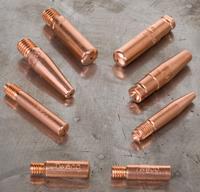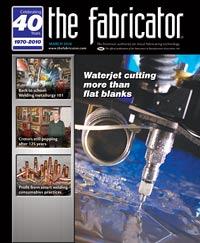- FMA
- The Fabricator
- FABTECH
- Canadian Metalworking
Categories
- Additive Manufacturing
- Aluminum Welding
- Arc Welding
- Assembly and Joining
- Automation and Robotics
- Bending and Forming
- Consumables
- Cutting and Weld Prep
- Electric Vehicles
- En Español
- Finishing
- Hydroforming
- Laser Cutting
- Laser Welding
- Machining
- Manufacturing Software
- Materials Handling
- Metals/Materials
- Oxyfuel Cutting
- Plasma Cutting
- Power Tools
- Punching and Other Holemaking
- Roll Forming
- Safety
- Sawing
- Shearing
- Shop Management
- Testing and Measuring
- Tube and Pipe Fabrication
- Tube and Pipe Production
- Waterjet Cutting
Industry Directory
Webcasts
Podcasts
FAB 40
Advertise
Subscribe
Account Login
Search
A GMAW consumables check list
Following these 7 tips can extend the life of your MIG front-end consumables
- By Jeff Henderson
- March 1, 2010
- Article
- Consumables

Figure 1All contact tips may look the same at first glance, but it's important to make sure you're using a tip with an opening that is not too tight or too loose for the wire being fed through it.
Welding consumables, as the name indicates, are parts that get consumed—either worn out or used up—during the welding process. Consumables include welding rods and wires, as well as front-end parts of welding guns, such as contact tips, nozzles, and diffusers.
As consumables get used up, the welding process has to be stopped, and new consumables need to be attached to continue welding. Therefore, it becomes important to consider how many of the consumables are used up during a shift and how often they need to be changed.
By following a few guidelines on consumables selection, care, and usage, you can extend the life of your gas metal arc welding (GMAW) front-end consumables and reduce the frequency of changing them, which in turn can lead to increased productivity, reduced downtime, and cost savings.
1. Match Tip Size With Wire Choice
When welding, you must match the contact tip opening to the wire size to reduce "wandering" of the wire inside the tip (see Figure 1).
Take care to ensure the wire is not too tight or too loose. A tight wire could cause a freeze-up inside the tip, while a wire that is too loose could cause arcing inside the tip.
2. Consider Quality
The internal diameter of your contact tip should always be smooth and free of burrs, extrusion marks, and other abnormalities from the manufacturing process. If present, these marks, which sometimes resemble tree bark, can cause the wire to pick up debris and deposit it at the exit end of the tip—or worse, in the weld puddle.
The quality of the nozzle and diffuser also affects downtime, as higher-quality consumables do not have to be changed as frequently. Smoothness and concentricity are important indicators of consumable quality.
3. Select the Right Alloy Types
Standard copper alloy 122 is the most common copper alloy used for contact tips. Other alloys include copper-chromium, copper-silver, and copper-chromium-zirconium, each well-suited for specific applications.
Nozzles and diffusers come in different alloy types, ranging from copper to brass to nickel-coated.
Be sure to check the manufacturer's recommended alloy type before starting any welding project.

Figure 2Many front-end consumables are available for all of the welding applications found in shops.
4. Maintain the Consumables Properly
A little bit of time and care will go a long way in increasing the life of your front-end consumables and, as a result, increasing your productivity.
It is important to remember to clean all nozzles to avoid heavy buildup of spatter inside the nozzle, which can affect the shielding gas coverage over the weld puddle. You also should remove any debris buildup on the tip/gas diffuser and around the gun handle and trigger with a wire brush to avoid downtime.
After the nozzle is clean, check to see that the tip, diffuser, and nozzle are in proper alignment as the manufacturer recommends. To save time and reduce hassles in the long run, always be aware of the tip quality and change it if necessary.
Taking proper care of conduit liners is equally important. This can be done by using a blast of high-pressure air to blow out the debris that comes off the welding wire. Additionally, if you use a felt wire wiper at the wire feeder end, reposition it after each new spool of wire to reduce debris buildup.
5. Consider Heavy-duty Consumables
Using heavy-duty front-end consumables can help extend part life. Because heavy-duty tips and diffusers have thicker walls than standard consumables, they act as a heat sink and deflect heat away from the front end, reducing damage to the front-end consumables that the high heat might cause.
Heavy-duty consumables especially make sense for applications in which heat buildup is intense and consistent. Such applications include high-amp jobs using mixed gases, which increases the operating temperature at the contact tip, and high-duty-cycle applications in which the consumables remain heated for long periods.
6. Ensure Proper Interface of the Contact Tip With the Diffuser
The interface, or mating surface, between the contact tip and the diffuser is critical in guaranteeing a high-conductivity electrical path. If the interface does not mate completely, the electrical path may be restricted, which results in reduced tip and diffuser life.
Be sure to follow the manufacturer's recommendation for proper attachment of the tip to the diffuser for a high surface area of contact at this interface. The electrical path should be through this interface; an electrical path through the threads in the contact tip is inefficient and could cause heat buildup in the contact tip.
7. Match Front-end Consumables to the Welding Application
Many operators ask if they should use tips recessed in the nozzle, protruding outside the nozzle, or flush with the nozzle. Actually, that question has no wrong answer. Matching the tip style to the application is tied, for the most part, to the operator's preference based on daily routine (see Figure 2).
In general, a recessed tip is used for high-heat applications when welding operators generally use a longer electrical stickout (ESO) and for applications in which the nozzle might touch the workpiece for tack welding, spot welding, or stitch welding.
A flush tip typically is used with a shorter ESO, sometimes resulting in shorter or tighter arc lengths that bring the tip closer to the workpiece.
A protruding tip is frequently used when welding open root passes in pipe welding applications or in other tight weld joints. The protruding tip should be monitored closely to prevent the tip from sticking to the workpiece.
Maintaining your consumables saves both time and money, and more important, let's you concentrate on creating the perfect weld. Always remember to consult with the consumables manufacturer's recommendations before selecting the most appropriate product for your next perfect weld.
About the Author
Related Companies
subscribe now

The Fabricator is North America's leading magazine for the metal forming and fabricating industry. The magazine delivers the news, technical articles, and case histories that enable fabricators to do their jobs more efficiently. The Fabricator has served the industry since 1970.
start your free subscription- Stay connected from anywhere

Easily access valuable industry resources now with full access to the digital edition of The Fabricator.

Easily access valuable industry resources now with full access to the digital edition of The Welder.

Easily access valuable industry resources now with full access to the digital edition of The Tube and Pipe Journal.
- Podcasting
- Podcast:
- The Fabricator Podcast
- Published:
- 04/16/2024
- Running Time:
- 63:29
In this episode of The Fabricator Podcast, Caleb Chamberlain, co-founder and CEO of OSH Cut, discusses his company’s...
- Trending Articles
AI, machine learning, and the future of metal fabrication

Employee ownership: The best way to ensure engagement

Steel industry reacts to Nucor’s new weekly published HRC price

Dynamic Metal blossoms with each passing year

Metal fabrication management: A guide for new supervisors

- Industry Events
16th Annual Safety Conference
- April 30 - May 1, 2024
- Elgin,
Pipe and Tube Conference
- May 21 - 22, 2024
- Omaha, NE
World-Class Roll Forming Workshop
- June 5 - 6, 2024
- Louisville, KY
Advanced Laser Application Workshop
- June 25 - 27, 2024
- Novi, MI


























